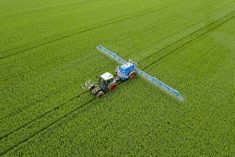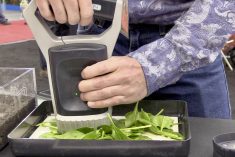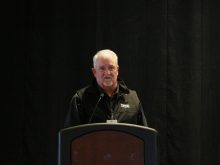“We cannot, nor should not have to, pay the entire bill to secure crop inputs.”
– DAVID MACKAY, CAAR
Canada’s farm supply dealers have renewed their call for federal assistance in upgrading agriretail sites to meet new and incoming security protocols.
Agri-retailers want Ottawa to cover half of the estimated $100 million cost of implementing security measures at 1,500 sites carrying high-risk products.
The support would be either a 50 per cent tax credit or a direct rebate for eligible security expenses at farm supply sites, according to a proposal by the Canadian Association of Agri-Retailers (CAAR).
Read Also

Manitoba sclerotinia picture mixed for 2025
Variations in weather and crop development in this year’s Manitoba canola fields make blanket sclerotinia outlooks hard to pin down
The industry needs help if it’s expected to increase on-site security against possible theft of agricultural fertilizers and chemicals which could be used for dangerous purposes, such as terrorism, said David MacKay, CAAR’s executive director.
“We’re prepared to do our part but we cannot, nor should not have to, pay the entire bill to secure crop inputs,” MacKay said.
Since 9/11, agri-retailers have come under pressure, both from government and the industry itself, to improve security at sites where agricultural chemicals are stored and sold.
Some dealers have voluntarily implemented security measures which include perimeter fencing, surveillance cameras, motion sensors, lighting, alarms and access controls.
CAAR feels such measures could eventually become mandatory under anti-terrorism and crime-fighting regulations.
Agri-retailers support increased security. But they want a comprehensive “shovel-ready” infrastructure upgrade program involving government as well as industry, instead of a piecemeal approach, said MacKay.
“From an agri-retail perspective, it’s a nightmare trying to manage all those regulations, both current and what we anticipate will be coming down the pike in the future,” he said.
“We’re trying to be proactive and saying, if we’re going to be facing all of these codes and they’re not going to harmonize well, why don’t we take a common sense approach up front that encompasses all of these potential codes and regs and harmonize them into one comprehensive common sense approach.”
The industry wants an approach that “would encompass all crop inputs, not just a few high-risk crop inputs, and then cost share it with the government,” MacKay said.
He said CAAR has spent three years seeking federal support without success, despite getting sympathetic hearings from several House of Commons standing committees.
CAAR is an industry association representing about 1,000 agri-retail members across Canada.
MacKay said the 2008 U. S. Farm Bill contained security tax credits for agri-retailers, putting Canadian dealers at a competitive disadvantage.
Current security measures affecting Canadian agri-retailers include: an industry code of practice for storing ammonia fertilizer; federal “restricted components regulations” requiring security measures for nine substances; Bill C-9, which amends regulations for transporting dangerous goods and which is presently before Parliament.
The ammonia code of practice becomes mandatory January 2011. MacKay said some agri-retailers tell him they will stop selling anhydrous ammonia because they can’t afford the cost of additional security for it.
The potential hazards of some crop inputs are well known. The classic example is ammonium nitrate (34-0-0), a white granular nitrogen fertilizer which is highly explosive if correctly mixed with fuel and detonated. It was used in the 1995 bombing of a federal building in Oklahoma City which killed 168 people.
Today, ammonium nitrate is no longer manufactured for agricultural use, although it is still used in controlled explosives for other industries, such as mining.
But it’s not just potential explosives which require heightened security in a post-9/11 era, MacKay said. For example, stolen pesticides could be used to contaminate public water supplies. [email protected]


















